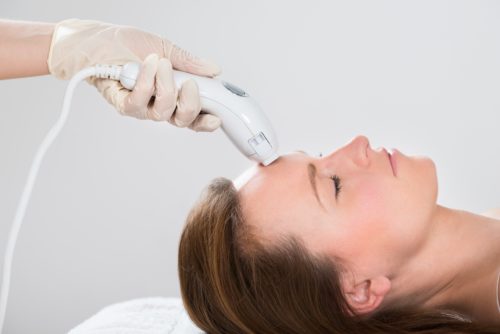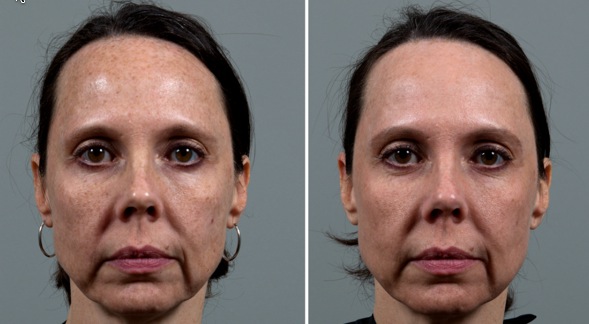Milia under the eyes can be frustrating and unsightly. These tiny cysts can appear stubborn and are often found in delicate areas like under the eyes. However, fear not!
If you’re wondering how to get rid of milia under eyes, this article will walk you through the easy ways to do it without hurting your skin.
What are Milia?
Milia are small, white cysts that can appear on the skin. They are most common on the face, but they can also appear on the body. These small white bumps are caused by dead skin cells getting trapped in the pores, leading to a buildup of keratin. They are harmless and do not need to be treated. However, some people may choose to have them removed for cosmetic reasons.
There are two types of milia:
- Primary milia: Primary milia are most common in newborns and infants. They usually go away on their own within a few weeks.
- Secondary milia: Secondary milia can develop at any age. They are often caused by skin damage, such as sunburn, blisters, or acne.
Causes of milia under eyes
Dr. Mona Gohara, a board-certified dermatologist and clinical associate professor at Yale School of Medicine, said that milia under the eyes are common skin condition that can be caused by a variety of factors, including genetics, skin type, and certain medications. One primary cause is the accumulation of dead skin cells, which can become trapped beneath the skin due to various reasons like dry skin, sun damage, or specific skin conditions. Another contributor is the buildup of keratin, a protein naturally present in the skin, hair, and nails. When keratin accumulates beneath the skin, it forms milia. Skin damage resulting from factors like sunburn, blisters, or acne can also pave the way for milia formation. Additionally, certain medications, including corticosteroids and isotretinoin, can elevate the risk of developing milia.
According to a 2020 study published in the Journal of Cosmetic Dermatology: Milia under the eyes are more common in women than in men, and that they are more likely to occur in people with fair skin. The study also found that milia under the eyes are more likely to occur in people with a family history of milia. While milia are more commonly associated with newborns and infants, they can arise at any age.
how to get rid of milia under eyes: home remedies
There are a few home remedies that you can try to remove milia under your eyes. However, it is important to note that these remedies are not always effective and may irritate your skin. If you have any concerns, be sure to talk to your doctor or dermatologist before trying any home remedies.
Warm Compresses
Begin by applying a warm compress to the affected area daily for a few minutes. This gentle heat helps to soften the skin, making it easier for the milia to surface and eventually release.
Exfoliation
Next, consider gentle exfoliation to encourage the removal of dead skin cells and reduce keratin buildup. Use a soft washcloth or a mild exfoliating scrub to delicately massage the affected area. This step aids in keeping the skin clear and the milia at bay.
Apple Cider Vinegar
Harness the antimicrobial and anti-inflammatory properties of apple cider vinegar. Create a mixture by combining equal parts apple cider vinegar and water. Apply this solution to the affected area using a cotton ball. Allow it to sit for a few minutes before rinsing it off with cool water. This can help in minimizing inflammation and promoting milia resolution.
Lemon Juice
Lemon juice, a natural astringent, can assist in drying out the milia. Apply a small amount of fresh lemon juice to the affected area with a cotton ball. Leave it on for a few minutes and then rinse it off with cool water. This can help facilitate the milia’s departure by reducing their size and prominence over time.
Medical treatments to remove milia under the eyes
Extraction
The most common method for milia removal involves a dermatologist using a sterile needle or lancet to carefully extract the trapped keratin from beneath the skin’s surface. This procedure is relatively quick and tends to be minimally painful, offering a straightforward solution for eliminating milia.
Dermabrasion
Dermabrasion is a slightly more invasive approach that employs a rotating abrasive wheel to exfoliate the top layer of skin. While effective for removing milia and various skin imperfections, it necessitates a longer recovery period compared to extraction due to its deeper impact on the skin’s surface.
Chemical Peels
Chemical peels utilize acidic solutions to exfoliate and remove the top layer of skin, offering another avenue for milia removal. This method is less invasive than dermabrasion and typically requires multiple treatments to achieve the desired results. Chemical peels can be effective in addressing milia while rejuvenating the overall appearance of the skin.
A 2022 study published in the Journal of Cosmetic Dermatology found that a combination of dermabrasion and chemical peels is an effective treatment for milia under the eyes. The study also concluded that this treatment is associated with a low risk of side effects.
tips to prevent milia
- Use a gentle cleanser and moisturizer. Avoid using harsh chemicals or exfoliants on your skin, as this can irritate your skin and make you more prone to milia.
- Keep your skin clean and dry. This will help to prevent dead skin cells and keratin from building up under your skin.
- Wear sunscreen when you are outdoors. Sun exposure can damage your skin and make it more likely that you will develop milia.
- If you are using any medications that are known to increase the risk of milia, talk to your doctor about other options.
- Exfoliate your skin regularly to remove dead skin cells and prevent them from building up under your skin.
- Remove your makeup before bed to prevent dirt and oil from clogging your pores.
- Get enough sleep. Sleep is essential for healthy skin. When you don’t get enough sleep, your skin can become dry and irritated, which can make you more prone to milia.
FAQs
- How long does it take to get rid of milia under the eyes? The length of time it takes to get rid of milia under the eyes can vary depending on the treatment method used. Some treatments may take several weeks or months to see results.
- Can you pop milia under the eyes? No, it’s not recommended to try and pop milia under the eyes as this can cause scarring and infection.
- Is it necessary to treat milia under the eyes? Milia under the eyes are generally harmless and do not require treatment. However, if they are causing cosmetic concerns, a dermatologist can recommend a treatment plan.
Final Takeaway
Milia under the eyes can be frustrating, but with the right treatment plan, they can be effectively treated. It’s important to consult with a dermatologist to determine the best course of action for your specific case and remembering to be patient and consistent with your treatment plan. Whether you opt for a topical treatment, in-office treatment, or a combination of both, there are options available for getting rid of milia under the eyes. By following the advice and tips outlined in this article, you can achieve smooth and clear skin around your eyes.





